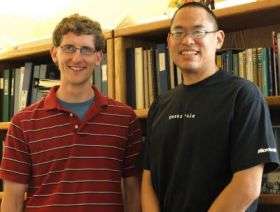Fuzziness on the road to physics' grand unification theory

Leave it to hypothesized gravity to weigh down what physicists have thought for 30 years. If theoretical physicists, led by the University of Oregon's Stephen Hsu, are right, the idea that nature's forces merge under grand unification has grown fuzzy.
At issue are grand unified theories that first appeared in the 1970s. They have suggested that, at short distances or high-energy scales, electromagnetic forces, strong forces, which bind quarks in protons and neutrons, and weak forces, which drive nuclear decay, will coalesce into a single unified field. Indications of this idea could appear at the Large Hadron Collider (LHC).
Hsu and colleagues applied advanced computations to qualities that might exist in quantum gravity in distance-shortened, high-energy interactions. Working with Hsu on the project, to be described in the journal Physical Review Letters, were UO doctoral student David Reeb and Xavier Calmet, a former postdoc in the UO's Institute of Theoretical Science and now of the Center for Particle Physics and Phenomenology at Catholic University of Louvain in Belgium.
"The energy scale at which these three forces become equivalent is probably very high," Hsu said. "We do not have a direct way to probe what happens. We cannot actually produce the energies or produce the particles necessary to directly test whether unification occurs, so we look for hints at lower energy scales -- and look at how the interactions change. We have seen indications that these three interactions are starting to unify. If you extrapolate these trends to very high energy, it looks like, in certain models or theories, they could unify -- all based on experimental data. If grand unification exists, it might be shown at the LHC."
Enter quantum gravity. It's not the physical law version as seen under of Isaac Newton's apple tree but rather a physical theory about gravitational interactions of matter and energy that may be vital to grand unification. This is the realm of space time and its curvature. Hsu's team looked closely at quantum gravity and the interactions of the forces at work using extrapolations built by mathematical magnification.
"It is believed that at short distances and high energies the actual structure of space time will start to exhibit quantum fluctuations," Hsu said. "So there would be fuzziness in the nature of space and time. The scale at which this grand unification might occur is getting kind of close to the scale where quantum gravity might exhibit this kind of fuzziness."
The fuzziness, researchers theorize, blurs the envisioned highway to unification. The blurring, they say, is brought about in the interplay of nature's forces, where, in certain models of unification, there may be thousands of yet-unseen particles at the boundary, affecting the highway itself.
"The interplay of these forces, in our theory, creates more uncertainty than people previously though could exist in this whole discussion," said Reeb, who performed much of the number crunching. "It's an important result, because it is telling people that when you look at the low-energy data and you extrapolate them you may have to be much more careful than was thought."
If grand unification is to be found, the discovery would move particle physicist closer to the proposed idea of supersymmetry, whereby particles at each level have corresponding qualities in another level as they spin. "Our research says there are more uncertainties to this argument than previously believed," Reeb said.
The bottom line, Hsu said, is that as data is generated in the LHC, interpretations as to relationships to grand unification may be more difficult for particle physicists to pin down.
Source: University of Oregon





















